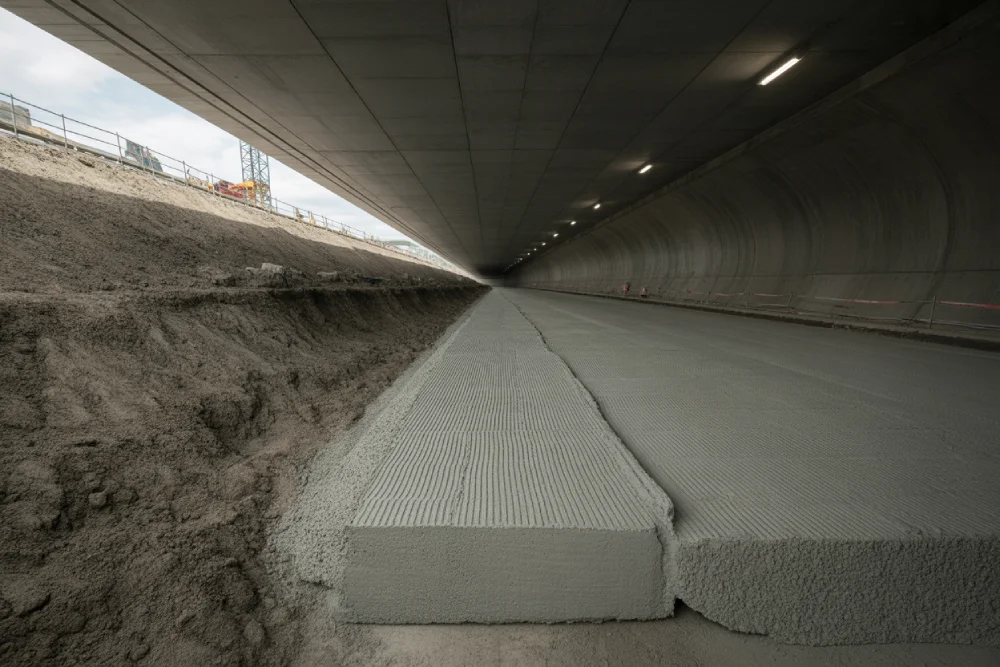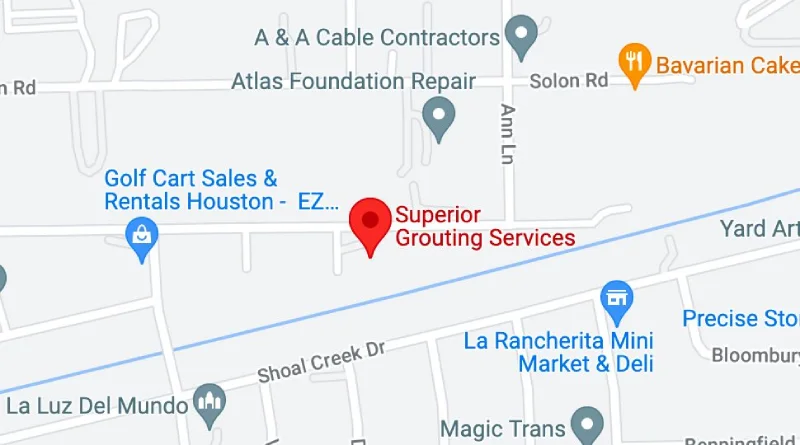The Future of Cellular Grout in Large-Scale Infrastructure Projects

Cellular grout's future in infrastructure projects shows robust growth with the market expanding from $1.5 billion (2024) to $2.8 billion (2033) at 7.5% CAGR, driven by urbanization demands, automation enabling precision application at scale, sustainability requirements reducing carbon 40-60%, and proven performance in tunnels, dams, and transportation infrastructure worldwide.
Large-scale infrastructure development faces mounting pressures from aging systems requiring replacement, urban population growth demanding expanded capacity, climate change necessitating resilient designs, and sustainability mandates cutting carbon emissions. Cellular grouting emerges as increasingly vital technology addressing these challenges through lightweight materials reducing structural demands, rapid installation minimizing construction impacts, material efficiency supporting environmental goals, and adaptability serving diverse applications from tunnels to dams. Market projections, technological innovations, and successful mega-project implementations demonstrate cellular grout's expanding role in next-generation infrastructure investment totaling trillions globally over coming decades.
Key Takeaways
- Global cellular grouting market grows from $1.5 billion (2024) to projected $2.8 billion (2033) representing 7.5% compound annual growth rate, driven by infrastructure modernization programs, urban expansion in Asia-Pacific and developing regions, and increasing adoption by transportation departments and federal agencies recognizing performance and sustainability advantages over conventional methods.
- Automation and robotics transform application methods through GPS-guided injection equipment ensuring precise placement, real-time density monitoring with automatic corrections, remote operation improving safety in hazardous environments, and data analytics optimizing mix designs based on accumulated performance data from thousands of projects creating institutional knowledge databases.
- Sustainability requirements increasingly favor cellular grout's 40-60% carbon reduction through material efficiency and alternative cements, reduced transportation emissions from lightweight properties, circular economy integration using industrial byproducts, and lifecycle cost advantages supporting infrastructure resilience goals against climate change impacts and natural disasters.
- Mega-project applications expand beyond traditional void filling to include high-speed rail tunnel backfill requiring consistent quality over miles of construction, dam and levee stabilization protecting populations from flooding, urban underground development enabling cities to expand vertically downward, and coastal protection systems defending against sea level rise and storm surge.
- Technological innovations including nano-enhanced formulations improving strength 25-35%, self-healing materials automatically sealing minor cracks, smart sensing capabilities providing continuous performance monitoring, and bio-based components reducing environmental impact position cellular grout as cutting-edge solution rather than commodity material for forward-thinking agencies and contractors.
- Challenges including higher material costs versus conventional alternatives, skilled labor requirements for proper application, quality control complexity at scale, and initial unfamiliarity among some agencies slow adoption but diminish as successful projects demonstrate value, training programs develop expertise, and specifications standardize ensuring consistent quality across projects and regions.
Market Growth Drivers and Projections
Understanding forces propelling cellular grout adoption helps agencies and contractors anticipate opportunities and prepare for expanding market demands.
Infrastructure Investment Trends
Unprecedented infrastructure spending globally creates massive opportunities for advanced materials and methods. The United States Infrastructure Investment and Jobs Act allocates $1.2 trillion for transportation, water systems, and utilities over coming years. Similar programs in Europe, Asia, and developing nations total trillions more in planned expenditure through 2035.
These investments prioritize three critical characteristics where cellular grout excels:
- Resilience: Ability to withstand extreme weather and climate change impacts
- Sustainability: Reduced carbon emissions and environmental footprint
- Rapid delivery: Faster construction minimizing disruption and delays
Traditional methods struggle meeting aggressive timelines while satisfying environmental requirements. Cellular grout's speed advantages, reduced carbon footprint, and proven reliability position it as preferred solution for agencies managing large infrastructure portfolios requiring consistent quality across multiple simultaneous projects.
Regional Market Dynamics
Growth varies geographically based on infrastructure needs, economic development, and technology adoption rates. The table below shows regional market characteristics:
| Region | 2024 Market Size | 2033 Projection | CAGR | Primary Drivers | Key Applications |
| North America | $520M | $920M | 6.8% | Aging infrastructure, sustainability mandates | Bridge approaches, dam rehabilitation, sinkhole repair |
| Europe | $380M | $710M | 7.2% | Urban density, environmental regulations | Tunnel construction, utility stabilization, historic preservation |
| Asia-Pacific | $450M | $890M | 8.1% | Rapid urbanization, mega-project construction | High-speed rail, metro systems, coastal protection |
| Middle East/Africa | $90M | $170M | 7.5% | Infrastructure development, oil sector | Foundation stabilization, industrial projects |
| Latin America | $60M | $110M | 7.0% | Mining sector, urban growth | Mine void filling, transportation infrastructure |
Asia-Pacific shows highest growth rates driven by massive infrastructure programs in China, India, and Southeast Asia. High-speed rail networks spanning thousands of miles require consistent tunnel backfilling and foundation stabilization where cellular grout proves optimal.
Application Segment Growth
Different infrastructure categories show varying adoption rates and growth potential:
Transportation Infrastructure (40% of market):
- Highway departments recognize benefits through successful bridge approach projects
- Railway operators adopt for tunnel applications and grade transitions
- Documentation of reduced maintenance costs drives specification
Water Infrastructure (25% of market):
- Federal agencies increasingly specify for dam and levee improvements
- Seepage control and foundation stabilization applications growing
- Climate adaptation programs expand coastal protection needs
Building Foundations (20% of market):
- Urban development on marginal sites with weak soils
- Existing structure underpinning for renovation projects
- High-rise construction enabling development on difficult ground
Geotechnical Stabilization (15% of market):
- Sinkhole remediation and void filling
- Mine subsidence prevention
- Utility protection and abandoned structure treatment
Technological Innovations Shaping the Future
Advances in materials, equipment, and application methods expand cellular grout capabilities and reliability for demanding infrastructure projects.
Automated Application Systems
Manual grouting operations introduce variability from operator skill differences, fatigue during extended shifts, and difficulty maintaining consistent parameters throughout large projects. Automation addresses these limitations through several key technologies:
GPS-Guided Injection Equipment:
- Precisely locates each injection point according to design specifications
- Eliminates layout errors that could leave voids untreated
- Logs every injection with location coordinates and parameters
- Creates comprehensive quality documentation automatically
Real-Time Density Monitoring:
- Nuclear gauges or pressure-volume relationships track density continuously
- Adjusts foam injection rates maintaining target density within narrow tolerances
- Achieves consistency impossible through manual operation
- Reduces material waste from batches failing acceptance testing
Remote Operation Capabilities:
- Places operators in climate-controlled stations away from hazardous environments
- Improves safety and reduces fatigue-related errors
- Enables single operators managing multiple pieces of equipment
- Essential for tunnel projects or difficult terrain applications
Advanced Material Formulations
Research into cellular grout chemistry continues producing formulations with enhanced properties addressing specific infrastructure challenges.
Nano-Enhanced Formulations:
- Nano-silica additions (1-3% by cement weight) densify microstructure
- Compressive strength improves 25-35% at equivalent densities
- Permeability reduces to 10⁻⁷ cm/sec or lower
- Enables applications previously requiring denser conventional materials
Fiber Reinforcement Technology:
- High-performance synthetic fibers beyond basic polypropylene
- Glass fibers and hybrid systems combining multiple fiber types
- Dramatically improves ductility preventing brittle failure
- Particularly beneficial for seismic regions requiring flexibility
Self-Healing Materials:
- Incorporates capsules of repair agents activating when cracks form
- Dormant bacteria precipitate minerals sealing defects
- Minor cracks sealed automatically before propagating
- Extends service life and reduces inspection frequency
Bio-Based Components:
- Foaming agents from renewable plant proteins
- Admixtures derived from natural polymers
- Reduces petroleum dependence while matching performance
- Positions cellular grout as environmentally preferred option
Smart Monitoring Integration
Embedding sensors within cellular grout during placement creates smart materials providing continuous performance data throughout infrastructure service lives.
Fiber Optic Monitoring:
- Distributed along cable lengths measuring strain, temperature, deformation
- High spatial resolution revealing stress distributions
- Identifies developing problems before visible distress appears
- Verifies design assumptions remain valid as structures age
Wireless Sensor Networks:
- Transmit data to central monitoring without physical access
- Remain dormant most of time, activating periodically
- Battery life extends to decades in low-power mode
- Essential for inaccessible locations like completed tunnel backfill
Machine Learning Analytics:
- Identifies patterns correlating with specific conditions
- Provides early warnings of issues requiring investigation
- Supplements engineering judgment with pattern recognition
- Processes data volumes humans cannot efficiently analyze
Large-Scale Infrastructure Applications
Specific project types demonstrate cellular grout's capabilities and future potential in major infrastructure categories.
High-Speed Rail and Transit Systems
High-speed rail construction represents one of cellular grout's most demanding and highest-value application categories. These systems require extremely smooth, stable track alignment maintained within millimeters over decades at speeds exceeding 200 mph.
Tunnel Backfilling Applications:
Tunnel boring creates annular spaces between segmental linings and excavated profiles requiring immediate filling. Cellular grout provides optimal solution through:
- Flowability enabling pumping hundreds of feet following tunnel boring machines
- Rapid strength gain allowing next ring installation within hours
- Controlled density reducing stress on weak ground or sensitive surface structures
- Complete void filling ensuring uniform support for linings
Bridge Approach Stabilization:
Elevated structures and bridge approaches benefit from cellular grout preventing settlement-induced problems:
- Uniform consistency matches approach grades to bridge deck elevations precisely
- Reduced weight minimizes foundation requirements on marginal soils
- Eliminates "bump at the bridge end" plaguing conventional construction
- Long-term stability prevents recurring maintenance needs
Dam and Levee Modernization
Water infrastructure built 50-100 years ago requires comprehensive upgrades meeting modern safety standards and adapting to climate change impacts. Thousands of dams show signs of internal erosion, inadequate seepage control, or foundation conditions not meeting current stability requirements.
Foundation Treatment Applications:
Cellular grout provides cost-effective solutions without requiring complete reconstruction:
- Creates cutoff walls controlling seepage that could cause piping failures
- Fills pervious zones beneath existing dams without drawdown
- Injection through small boreholes minimizes operational disruption
- Maintains water supply, power generation, and flood control services
Emergency Stabilization:
When monitoring detects developing problems during high water events:
- Material mobilizes within hours providing rapid stabilization
- Sets quickly creating effective barriers or void filling
- Prevents catastrophic failures while permanent solutions are designed
- Probably saves more lives than any other cellular grout application
Toe Berm Construction:
Slope stability improvement traditionally uses earthfill requiring extensive work. Cellular grout toe berms provide advantages:
- 60% less weight achieves equivalent stability improvement
- Smaller footprint conserves limited right-of-way
- Faster construction minimizes flood protection gaps
- Reduced lateral pressures benefit existing dam faces
Urban Underground Development
Cities expanding vertically downward through deep basements, underground transit, and utility tunnels encounter challenging ground conditions and must minimize impacts on adjacent existing infrastructure.
Foundation Underpinning:
Supporting existing buildings during adjacent excavation requires careful approach:
- Lightweight cellular grout adds support without overstressing marginal soils
- Flowability reaches beneath footings through small injection ports
- Reduced weight limits stress increases on soft urban soils
- Prevents settlement that would damage existing structures
Utility Protection:
Catastrophic utility failures during excavation create massive disruptions:
- Cellular grout injected around pipes provides support maintaining alignment
- Flows around complex utility networks filling voids from construction
- Maintains soil contact preventing differential movement
- Stops breaks that would close streets and interrupt services
Abandoned Structure Treatment:
Legacy infrastructure reaching end of service life requires proper closure:
- Old transit tunnels, coal tunnels, utility conduits need stabilization
- Cellular grout fills structures completely through remote injection
- Prevents future collapse creating sinkholes beneath active streets
- Accomplishes stabilization without excavation paralyzing urban areas
Sustainability and Environmental Advantages
Infrastructure sustainability goals increasingly influence material selection as agencies commit to carbon reduction targets and circular economy principles.
Carbon Footprint Reduction Quantified
Cellular grout's environmental advantages extend beyond general claims to quantifiable benefits. The table below compares impacts for a representative project (10,000 cubic yards fill):
| Impact Category | Conventional Fill | Cellular Grout | Reduction | Environmental Benefit |
| Portland Cement (tons) | 2,400 | 1,200 | 50% | Reduced limestone mining, kiln emissions |
| CO2 Emissions (tons) | 410 | 180 | 56% | Climate change mitigation |
| Truck Deliveries | 520 | 220 | 58% | Reduced traffic, air quality |
| Diesel Fuel (gallons) | 9,800 | 4,200 | 57% | Fossil fuel conservation |
| Excavated Material (cy) | 12,000 | 2,000 | 83% | Reduced disposal impacts |
These reductions translate to meaningful progress toward carbon neutrality goals many agencies established for 2030-2050 timeframes. Large infrastructure programs using cellular grout across dozens of projects achieve emissions reductions equivalent to removing thousands of vehicles from roads annually.
Circular Economy Integration
Infrastructure sustainability increasingly emphasizes keeping materials in productive use rather than extracting virgin resources and disposing waste.
Industrial Byproduct Utilization:
- Cellular grout formulations incorporate 30-50% fly ash, slag, or similar materials
- Finds beneficial use for byproducts otherwise requiring landfill disposal
- Simultaneously reduces virgin cement consumption
- Directly supports circular economy principles
Recycled Aggregate Applications:
- Demolished concrete provides sustainable alternative to quarried stone
- Cellular grout tolerates higher recycled content than conventional concrete
- Creates outlet for construction demolition waste (25-40% of solid waste)
- Diverts substantial material volumes from landfills
Water Recycling:
- Treated wastewater, stormwater, or industrial process water substitutes for potable supplies
- Tens of thousands of gallons saved per project
- Addresses water scarcity affecting construction globally
- Closed-loop washing systems capture equipment cleaning water for reuse
Lifecycle Environmental Performance
Beyond construction phase impacts, cellular grout's long-term performance provides environmental benefits throughout infrastructure service lives.
Maintenance Reduction Benefits:
- Superior void filling prevents settlement reducing maintenance interventions
- Each avoided repair eliminates associated emissions and impacts
- Multiplies initial construction sustainability benefits over 50-100 year lifespans
- Cumulative environmental advantages exceed construction phase reductions
Extended Service Life:
- Durability in harsh environments reduces replacement frequency
- Performance in marine, aggressive groundwater, or freeze-thaw conditions
- Avoided reconstruction every 20-30 years creates substantial cumulative benefits
- Lifecycle environmental advantages compound over infrastructure design lives
Economic Considerations and Value Proposition
Understanding cellular grout economics beyond simple material cost comparisons reveals competitive position for large-scale infrastructure investment.
Lifecycle Cost Analysis
Initial construction represents only 20-40% of total infrastructure ownership costs over typical 50-100 year design lives. The table below illustrates lifecycle economics for highway infrastructure (per mile, 30-year analysis):
| Cost Category | Conventional Fill | Cellular Grout | Advantage |
| Initial Construction | $800,000 | $950,000 | Conventional |
| Year 1-10 Maintenance | $120,000 | $45,000 | Cellular |
| Year 11-30 Maintenance | $280,000 | $95,000 | Cellular |
| Major Rehabilitation (Year 25) | $400,000 | Not Required | Cellular |
| Total 30-Year Cost | $1,600,000 | $1,090,000 | 32% Savings |
Reduced maintenance from superior void filling and extended service life from enhanced durability create substantial lifecycle advantages despite higher initial costs.
Risk Mitigation Value
Large infrastructure projects face substantial risks affecting economics beyond quantified costs and benefits.
Schedule Risk Reduction:
- Rapid installation reduces critical path vulnerability
- Weather tolerance minimizes weather-related delays
- Liquidated damages for late completion avoided
- Political pressure for expedited delivery satisfied
Performance Risk Mitigation:
- Consistent quality regardless of encountered conditions
- Complete void filling prevents future settlement surprises
- Adaptability addresses subsurface conditions varying from investigations
- Documented long-term success reduces uncertainty
Environmental Compliance:
- Lower emissions and minimal waste simplify regulatory approval
- Reduced excavation impacts satisfy stakeholder concerns
- Demonstrable sustainability advantages overcome opposition
- Avoided delays and permit modifications create real value
Challenges and Limitations
Realistic assessment acknowledges obstacles to cellular grout adoption alongside opportunities and advantages.
Cost Premium Perception
Material unit costs 50-150% higher than conventional fills create initial concerns for agencies unfamiliar with total project economics. Several factors contribute to this challenge:
- Budget processes focus on line-item costs rather than total installed costs
- Procurement methods reward lowest bid regardless of technical merit
- Lifecycle value analysis not standard practice in all agencies
- Stakeholder unfamiliarity with cellular grout advantages
Overcoming perception requires education demonstrating total project costs often prove competitive and lifecycle value strongly favors cellular grout through reduced maintenance and extended service life.
Technical Expertise Requirements
Proper cellular grout application requires specialized capabilities not universally available:
- Knowledge of foam generation, density control, and injection monitoring
- Equipment specific to cellular grout application
- Experience with quality control complexity
- Understanding of project-specific mix design optimization
Training programs, certification systems, and standardized specifications address expertise gaps but require time developing. Industry associations, material suppliers, and leading contractors offering training help build knowledge base enabling wider adoption.
Specification Standardization Needs
Lack of standardized specifications across agencies creates barriers:
- Engineers unfamiliar with cellular grout hesitate without established precedent
- Custom specifications required for each project increase design effort
- Variable requirements between agencies confuse contractors
- Limited readily available guidance for specification development
Professional grouting services assist agencies developing appropriate specifications. Organizations like American Concrete Institute and International Grout Association working toward consensus documents will accelerate adoption as standardized references become available.
Conclusion
Cellular grout's future in large-scale infrastructure proves bright with market growth to $2.8 billion by 2033 driven by proven performance, sustainability advantages, and technological innovations. Automation enhances quality and efficiency at scale. Advanced formulations expand structural capabilities. Smart materials provide continuous monitoring. Sustainability benefits align with carbon reduction commitments.
Mega-projects in transportation, water infrastructure, and urban development increasingly specify cellular grout recognizing technical and economic advantages. Challenges including cost perception, expertise requirements, and specification standardization gradually diminish as successful applications demonstrate value. For agencies planning major infrastructure investments, contact Superior Grouting to discuss how cellular grout delivers performance meeting next-generation demands.

